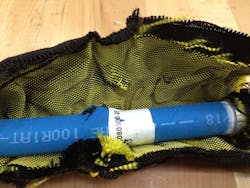Safety Sleeves for Hydraulic Hose Failures
Careful design and the use of quality hoses and fittings in mobile hydraulic systems significantly reduce the prospect of malfunction that can cause harm to people. That said, severe injury from a good hydraulic hose gone bad is an ever-present hazard for those who operate and repair equipment. Ruptured hoses spray scalding oil, and a pinhole leak in a hose with as little as 100 psi of residual pressure can inject fluid into a human hand with bullet-like speed—an injury that initially leaves only a small puncture wound that seems of little consequence, but almost always requires immediate surgery to rescue limb—and perhaps life.
Recognizing the potential danger of catastrophic hose failure, especially from hoses positioned close to the operator and in the operator’s line of sight, several hydraulic-hose manufacturers (Gates, Eaton and Parker Hannifin, among them) have developed sleeve material designed to shield operators from bursting hoses, and in some instances, from pinhole leaks.
The LifeGuard sleeve system, says Gates’ Jason Caldwell, hydraulic product line manager, is a joint venture between Gates and a nylon-sleeve manufacturer. The sleeve manufacturer developed and patented both the sleeve material and the double-layer weaving process, he says, and Gates developed and patented the special clamp used in installing the sleeve.
According to Caldwell, clamps are installed with a standard crimping machine using a special die that forms the clamp in a manner to keep the sleeve in place, but to allow fluid escaping from a hose to drain past the clamp, preventing pressure buildup within the sleeve and providing an unmistakable indication that the hose needs attention.
Gates offers the LifeGuard sleeve with three pressure ratings and in a range of sizes to fit hoses up to 1 inch in diameter. Maximum ratings for the sleeve include containment of hose bursts up to 10,000 psi and containment of pinhole leaks at 250F for up to five minutes.
Costs vary with size and length of sleeve, of course, but using as an example a 4-foot-long, ½-inch, 3,000-psi, wire-braided assembly with couplings, the company estimates that adding line-of-sight sleeve would result in an approximate additional cost of 45 percent. If, however, that hose assembly were already equipped with an abrasion-resistant sleeve and line-of-sight sleeve is substituted, the added cost would drop to an estimated 16 percent.
Douglass reminds machine users, however, that the cost of line-of-sight sleeve can pale in light of expenses incurred for a serious burn injury or a hydraulic-injection mishap. OSHA estimates for costs associated with a hydraulic-injection injury, he says, typically approach $150,000.
“You can try to raise awareness about the added safety potential of line-of-sight sleeve,” says Caldwell, “but sometimes it’s not until there’s a personal connection with the real costs of failure or injury that the economics become clear.”
According to Greg Reardon, business development manager at Parker Hannifin, development of the company’s new Partek Defense line-of-sight sleeve, announced 18 months ago, was prompted in part by safety concerns being voiced more frequently by customers.
“Use of line-of-sight sleeve has been on a steady upward climb as more people become aware of its potential to address safety issues and as OEMs go through design cycles,” says Reardon. “We see interest both from the OEM and from end users through dealers.”
Partek Defense sleeve, available in five standard interior diameters, uses a proprietary weave pattern and is designed to contain hose bursts up to 12,000 psi. The sleeve, however, is not rated for pinhole leaks. Reardon explains:
“Parker does not rate the sleeve for pinhole leaks. At present, there are no industry standards for evaluating pinhole leaks and no way to determine if manufacturers are testing in the same way—for instance, hole diameter, pressures involved, and whether the leak is continuous or intermittent. The industry needs a specification to ensure that everyone is using the same, consistent test method. If that occurs, we’re willing to rate for pinhole leaks.”
According to Reardon, Parker investigated various clamping methods for the sleeve and chose a banding-type clamp installed with a simple hand tool. The clamp is installed on the shell of the fitting, he says, and creates natural pathways for the fluid to escape and to prevent pressure build-up within the sleeve.
The cost for Parker’s line-of-sight sleeve is approximately twice that of the company’s conventional abrasion-resistant sleeve, says Reardon, but it performs in a manner that conventional sleeving can’t match:
“ISO 3457 says that certain hydraulic hoses require guarding, so some folks might use an abrasion-resistant sleeve. But we’re quick to point out that, although such a sleeve might provide minimal protection, it will fail at a much lower pressure rating. Engineers and machine owners alike should also keep in mind that line-of-sight sleeve doesn’t replace good, sound practices for the proper assembly and routing of hoses; don’t rely on the sleeve to compensate for an incorrectly crimped fitting or for kinking a hose around a corner in the machine.”
Kelly Moore-Floyd, product manager for Eaton’s line-of sight sleeve, Guardian Sleeve, reiterates and expands a previous point, saying that ISO 3457 is “an entirely voluntary standard and only pertains to the line-of-sight issue and addresses only mobile, off-highway equipment.”
According to Eaton, Guardian Sleeve uses an “ultra-tight, polyamide, six-weave construction that enables it to restrain hose bursts up to 16,000 psi and to deflect 1-millimeter pinhole leaks at 4,000 psi,” while also meeting industry standards for abrasion resistance and flame resistance. Guardian Sleeve is available for ¼-inch to 1½-inch hose diameters.
Eaton developed Guardian Sleeve not out of a regulatory mandate, says Moore-Floyd, but essentially from recognizing a growing concern among customers for such a product—coupled with the company’s concern for safety and its active participation in industry-standards committees.
Her advice for users of line-of-sight sleeve: Install the product strictly to the manufacturer’s specifications, including cutting to proper length to accommodate hose bends, sealing cut edges if required, and using specified clamps installed with the recommended tool.


